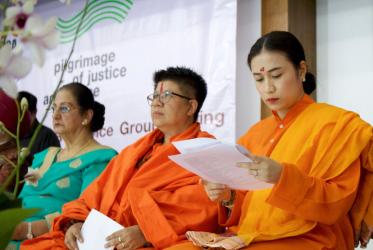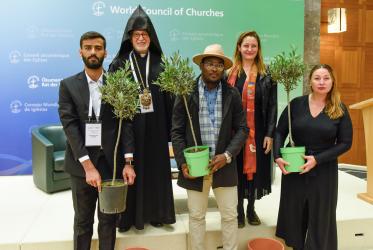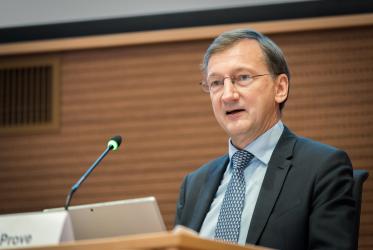Spirituality of Pilgrimage – a Way Towards Peace Between People of Faith
Round Table on Societies in Transition: The Role of Inter-Religious Dialogue and Cooperation
The Message of the 10th Assembly of the WCC, from Busan, Korea, November 2013, as it reads in paragraph 6:
“We intend to move together. Challenged by our experiences in Busan, we challenge all people of good will to engage their God-given gifts in transforming actions.
“This Assembly calls you to join us in pilgrimage.
“May the churches be communities of healing and compassion, and may we seed the Good News so that justice will grow and God’s deep pest rest on the world.”
Pilgrimage of peace – it brings us beyond negotiations, statements and round tables. However, it is in my mind very relevant for our reflection about how we make a difference – in the minds of ourselves and others, and in the world we share. Commitment, collaboration and challenge seem to me to capture something significant about the spirituality of pilgrimage and its potential for acting as a way to peace between people of faith. Pilgrimage is written into the fabric of many religions. It is not an accident, I think, that pilgrimage is a phenomenon known and experienced in most of the great religions of the world. It has been said that the largest peaceful gathering in the whole of human history was the 2013 gathering for the Hindu religious festival of Kumbh Mela held at Allahabad.
Pilgrimage is written into the fabric of many religions. Pilgrimage is significant in Christian spirituality, particularly in Orthodox and Catholic churches. We are aware from the Hebrew scriptures of the biblical basis of the pilgrimage tradition which has influenced the spirituality of all three Abrahamic religion. The performance of the Hajj in Mecca is one of the five pillars of Islam incumbent upon all Muslims. Additionally, there are very interesting new developments in this regard, even amongst Protestant Christians, pilgrimage is undergoing a renewal, as it becomes the sign of a new era of openness to spirituality.
This will not necessarily be a spirituality defined by the churches – at least not alone. There is no direct equivalent to Mecca in Christianity, perhaps because we have different places of pilgrimage in our different church families and perhaps because we are rather more ambiguous in our faith about the significance of place. There is, however, no doubt about the significance of Jerusalem and Bethlehem for Christians. But there can be serious questions whether the pilgrimages to Jerusalem have been and always are pilgrimages of peace.
Peace cannot be totally separated from place or places. And yet our ambiguity about the link between pilgrimage and physical place correspondingly offers us the possibility of using the language of pilgrimage in a more metaphorical way – to describe the quest for peace and justice, and our desire and determination to work with one another as people of faith in relation to this. One of the texts from Christian scripture which is most important to me and which belongs to our morning prayers is the Song of Zechariah from the Gospel of Luke. It ends with the invocation to God, to “guide our steps into the way of peace”. If, taking these words which echo the vision of pilgrimage as our marker, we pray to God to lead us on a pilgrimage of peace – what will be its characteristics, what will be its spirituality?
Let me share some reflections from an experience of work-related travel that also had a dimension of pilgrimage for me, knowing well that the WCC General Secretary’s travels are not models for pilgrimage.
My most recent international visit on behalf of the World Council of Churches with a significant interreligious component was a journey I made in February to Iran. There were two elements to my visit – the first was our continuing to sustain and develop the ongoing relationship of dialogue between the World Council of Churches and the government-backed Iranian Centre for Interreligious Dialogue based in Tehran; the second was to show support and solidarity for our member churches in the country.
We were treated very hospitably by our Muslim hosts. They had heard that we had wanted to visit Isfahan, so they arranged for us to do so, taking us by way of the holy city of Qom to see their institutions of studies – including inter-religious studies and a remarkable collection of Islamic texts. I think all of us in the party who had not previously visited Isfahan had our breath taken away by the sheer beauty and magnificence of the buildings in the centre of the city of Isfahan, designed and built several centuries ago for a Muslim ruler with the help of the substantial and ongoing Armenian civilian presence in the city, featuring one of the most beautiful Armenian churches I have seen. It was a long journey to Isfahan overland from Teheran and Qom, building personal relationships between one’s hosts, the members of the delegation from different continents and members of the Christian churches in Iran. Visiting these place together, it became a joint pilgrimage.
That visit was a true combination of commitment, collaboration and challenge. We in the World Council of Churches are committed to sustaining and developing long-standing relationships with significant bodies and groups representing other faiths – not simply for the sake of relationships, but so that we can collaborate and partner with them more widely in relation to issues of peace and justice. Our relationship with the Centre for Interreligious Dialogue goes back to the middle of the 1990s, and has been sustained by several bilateral visits between Geneva and Tehran since then. If we were not already aware of this, our visit to Iran in February convinced us even more of the potential and the important role that Iran, and religious leaders and the people of Iran, could and should play in peace-building. Our expectations towards their contribution to peace should be congruent to their role in the Middle East, but also in relation to wider issues that contribute to the peace of our world. Excluding them from the table in Geneva at the Syrian peace talks in February this year was not helpful, I believe.
During our time in Iran, we could not but be aware of how climate and ecological worries were impinging upon the lives of the people of that country. The dried-up bed of the river which until recently flowed through the centre of Isfahan was an all too obvious example. The challenges posed by environmental changes and crisis are the same for all, irrespective of faith. More and more they matter in the perspective of peace – peace with the earth and peace in the communities. It is certainly an area where Christians need to work with Muslims and other people of faith for the good of us all. We do hope that our Iranian hosts will accept our invitation to help to sponsor the planned climate change meeting we are organizing in New York this September.
That visit to Iran involved a fair amount of commitment for both ourselves and our Iranian hosts: for them the commitment in time and resources to facilitate our visit and to make it as interesting and worthwhile as possible, for ourselves being in a place where the modalities of dress and behaviour were not those to which our women fellow pilgrims are normally accustomed.
Collaboration, commitment – and challenge: that third element was also present – because alongside working with religious others, there were points when our visit required us to challenge them gently, too. Our insistence on visiting our member churches in the country was an intentional reminder that we cared about the human rights of our Christian co-religionists in Iran, and that the value of religious freedom was important to us.
Pilgrimage is about true spirituality and true humanity. There is something in the connection between body and soul, united in a spiritual dimension, that is revealed in the life of a pilgrim. It is difficult to be artificial or superficial as a pilgrim; it is a very realistic approach to spirituality. On the other hand, it is a way to connect our lives with everything and everybody that God has created. I hope and pray that this focus on pilgrimage can make us able to be more honest and authentic human beings, to ourselves and to one another, open to the ways God’s spirit is guiding us, as we are but also in the world as it is.
Thereby we are already bringing in a new dimension to the definition of the goal of our pilgrimage. A pilgrimage of justice and peace could be to any place where justice and peace are threatened, and particularly there, be it in places of conflicts or in relationships of oppression and injustice across borders in any place of the world. We should pray that God leads us there, not for our curiosity, but for our true and honest will to be in solidarity and willing to do something to bring justice and peace.
The pilgrimage perspective is one that makes us all humble and open for changes, for repentance and something new and better. Pilgrims are open to what they will see on their way and what they can learn from the way, in seeking their goal. This is an attitude of openness but also of searching the real and sustainable values that can bring us all to a better world.
Therefore, there is a strong connection between the many reflections and recommendations of being mutually accountable to one another in dialogues and within the motif of pilgrimage. To give account to one another, and to be accountable for what we share, is not a matter of writing, or even signing statements or covenants for the files or the shelves. We share and we are in dialogue together, to be mutually accountable in our attitudes to one another. The purpose of dialogue is not to ignore differences and difficulties, but not to be limited by the definitions and problems of the past.
Some focus on the goal of pilgrimage which is to return home – but in a changed condition. Others point out that in the pilgrimage traditions it is widely recognized thate pilgrims may perhaps not return to their home. Either way, we are not going to be left unmarked as we journey to our goal.
But actually the motif of pilgrimage requires of us an additional commitment – because it is not simply the goal of pilgrimage which is significant but the actual process, the way, the journey itself. As we travel on pilgrimage, we discover that it is in the truest sense an eschatological activity in which God’s future is already invading and rescuing the present; we are being given a literal foretaste of God’s rule, God’s realm… now. In the WCC at the moment we are organizing our work around a “pilgrimage of justice and peace”: and we ourselves are very clear that it is a pilgrimage OF justice and peace rather than a pilgrimage FOR justice and peace. We intend to say by this that our way of journeying itself – as well as its goal – must be linked to and foster justice and peace.
For Christians, the ultimate pilgrimage prayer is the one Jesus himself taught his disciples when – according to Luke’s gospel – he himself was already on pilgrimage to Jerusalem: ‘Your kingdom come, your will be done’. It is telling in fact that our developing vision of this pilgrimage of justice and peace stems from the prayer which encapsulated the theme of our recent 10th Assembly in Busan, South Korea: God of life, lead us to justice and peace. Pilgrimage and prayer belong intrinsically together. Our intended pilgrimage of justice and peace is seeking to put our Assembly prayer into practice.
Pilgrimage both offers us the opportunity of working collaboratively with those of other faiths – and secular groups and organizations – and of being strengthened by such collaboration. The precise and exact goal of the pilgrimage, our various “ultimate ends”, may be different in different religions… but we can mutually recognize that we are all travelling on the way of justice and peace. Nobody can make peace alone.
The church leaders of South Sudan have in the last few days shown that accompaniment of the leaders of their country, who are responsible for ending the war there, is a significant part of their ministry. This collaboration is not simply a gesture of convenience; rather, it is a recognition that the shared journey binds us together.
In the pilgrimage literature of many religions – including Christianity – there are many tales of how one pilgrim is unexpectedly helped – even saved – by another, even though they may later go their separate ways and disappear from each other’s sight. But for a space of time –sometimes even only a brief while – their collaboration has been essential to the success of the pilgrimage being made by each party. As we journey collaboratively together, we can hear the stories of our fellow travellers, what has made them what they are, what has brought them to this place, what are their hopes and fears, and that can in itself become an expression and extension of the pilgrimage of justice and peace.
One of the insights from the biblical tradition is that God travels on pilgrimage with God’s people: whether in the Old Testament images of cloud and fire, or in the New Testament accounts of the figure of Jesus who journeys with his disciples to Jerusalem, and to Emmaus – and his promise to be with them till the end of the world. If God is travelling with us on this journey, then we must expect to be challenged. God travels with us not simply as comforter, but also as challenger.
The very modality of pilgrimage, the need to travel light, is surely challenging for many of us, but it is also liberating: We have to leave something behind us.
If vulnerability is indeed an essential part of the spirituality of pilgrimage, then I do believe that the challenge to accept and honour that vulnerability is a positive one, enabling people of different faiths to work together for peace in our world. We will meet the Holy where the holy life created by God is vulnerable and threatened. We are called to do holy work together – for justice and peace. Therefore we need to be able to move together.
Rev. Dr Olav Fykse Tveit
WCC general secretary


